Bulletproof build
COMPUTEX, the Taiwanese PC-centric trade show, is an opportune time to launch a product or two. German cooling specialists be quiet! did just this with the announcement of the premier Dark Power Pro 10 recently. Encompassing six capacities - 550W to 1,200W - we take a closer look at the 650W jobbie.
Now available to the enthusiast for around £125, or at the very high end of the pricing spectrum for a supply of this capacity, it needs to be stellar in every department in order to attract attention.
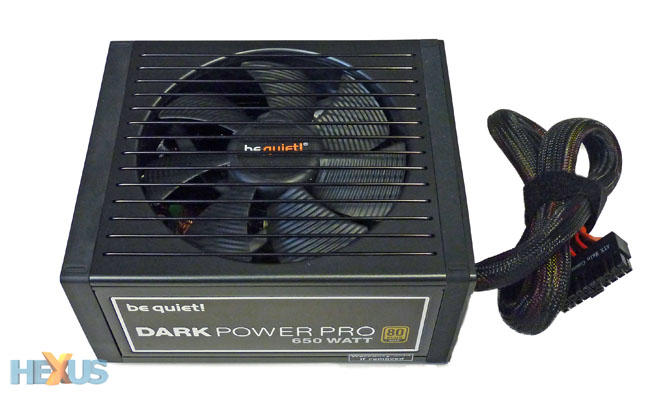
;
Open the box and it looks similar to the previously-reviewed 680W SP E9 CM. Be quiet! fan grilles look the business and the PSU, measuring 180mm x 150mm x 86mm, is finished off nicely, with rubberised sections around the edges that, one would assume, help reduce vibrations in cheaper chassis. These rubber bumpers hide the screws that keep the chassis together and a lack of visible screws translates to a clean aesthetic.
Premium supplies tend to have modular connectors; this one is no different, as the 24-pin (20+4-pin) ATX is the only one tied to the chassis. For what it's worth, we like the way it's attached to the PSU; it gives the supply an air of quality. The remaining cables are provided in a bag and hook up to the right-hand side.
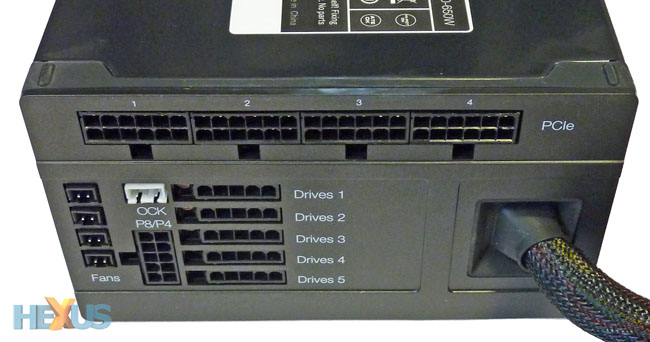
Zooming into the cable-connecting system, peripheral power lines the right-hand side. The sets of cables are arranged thus:
| Cables | Cables, type, length, plugs on cable | |||||||
|---|---|---|---|---|---|---|---|---|
| Main | x1 20+4-pin (60cm) | |||||||
| ATX/EPS | x1 P4+P4 (70cm) | ATX/EPS 2 | x1 P4+P4 (70cm), 1 x P8 | |||||
| PCIe 1 | x1 6+2 (60cm) | |||||||
| PCIe 2 | x1 6+2 (60cm) | PCIe 3 | x1 6-pin (60cm) | |||||
| Peripheral 1 | x2 SATA, x2 Molex, FDD | |||||||
| Peripheral 2 | x3 SATA (60-90cm) | |||||||
| Peripheral 3 | x3 SATA (60-90cm) | Peripheral 4 | x1 SATA (50cm) | Peripheral 5 | x3 Molex | Peripheral 6 | x1 Molex (50cm) | |
Whoa, Marie, the PSU has tentacles sprouting from it. The array of cabling is immense for a PSU in this class, including five graphics card-specific connectors, nine SATA cables, and six Molexes.
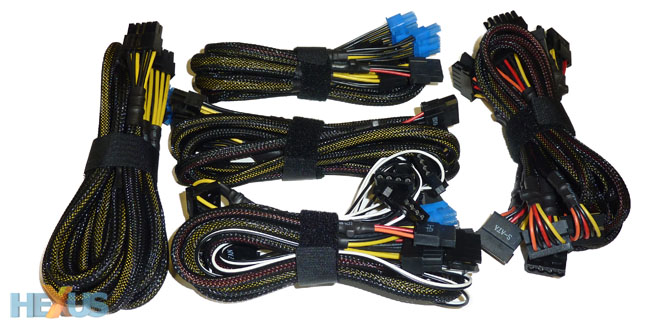
Bundled with one of the sets are a further four Molex connectors that attach to the fan-header on the left-hand side of the PSU. These drive attached fans without the need to trouble the motherboard's on-board headers, and temperature is regulated by an on-PCB sensor within the PSU.
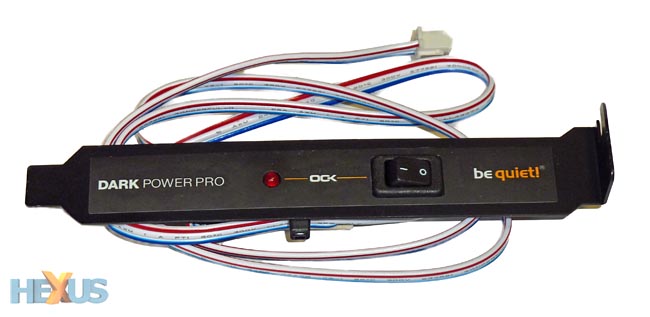
Yet there's more, be quiet! also throws in what it calls the 'Overclocking Key.' Connecting to the only white-coloured connector on the PSU and to a spare PCI expansion slot plate on the back of the chassis, the very nature of the 12V DC delivery can be changed. Some argue that it's better to split the 12V output into specific rails and then attach a meaty component on each, via the PCIe or P4 plugs. Others say it makes more sense to have a single 12V rail, eliminating the need to factor the maximum per-rail load into account. Shipping from the factory, the unit has a four-rail topology, but flick the switch and it turns into a single-rail beast. Folk who can't be bothered to install the bracket can also use the in-box jumper and achieve the same toggling effect.
The supply
Be quiet! goes to great lengths in discussing the multifarious improvements over the previous generation of supplies. For what it's worth, the lower-wattage PSUs in the P10 range - 550W, 650W, and 750W - are based on a new design from industry stalwart FSP. Meanwhile, the larger-capacity models take the guts of Seasonic's latest PSU thinking.
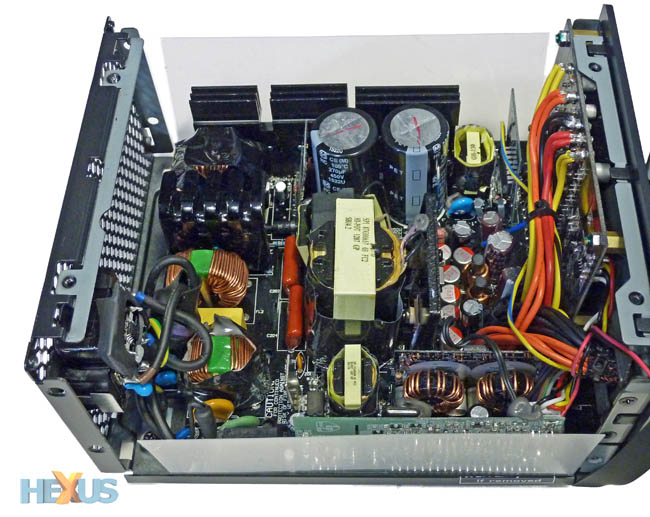
The PCB claims practically all the area within the chassis; we've seen previous 650W PSUs use significantly less real estate. 550W-750W P10s use what is known as a half-bridge architecture, or two MOSFETs, compared to the full-bridge's four, as found on the 850W-plus designs. Thinking about it from a current flow point of view, the supply has two X-type caps, three Y-type caps and a metal-oxide varistor (MOV). Don't worry if this doesn't mean a whole heap to you; their job is to the filter the current as it goes towards the AC/DC rectifier, ensuring that it's as smooth and spike-free as possible.
Moving along, this smoothed AC feed is converted (rectified) by a single rectifier and the resultant feed is sent over to the active (noiseless) PFC, boosted, and then fed/stored in the big-ass caps you see dominate the middle-back of the above picture.

Looking at it from the other side, the caps, made by Panasonic and rated to 105°C, are more than up to the job of holding the rectified DC current. It's fairly straightforward to take a base design, such as this one from FSP, and rebadge it. Be quiet!, however, says it has gone the extra mile in designing the Dark Power Pro range. Ripple filtering is handled by a glut of high-quality CapXon caps, soldering is good to very good.
Perhaps most importantly of all, the firm uses a decent fan in order to keep the noise in check. Part of the SilentWings 2 range and 135mm in size, the fluid dynamic bearing (FDB) fan and associated grille are designed to keep noise at a minimum. Be quiet! reckons the fan never spins up to even half of its maximum 1,800rpm, leading to 834rpm at 100 per cent load and just 615rpm at 60 per cent load. The fan doesn't switch off at low loads, we note, but it's spinning so slowly that it's unlikely to be heard. We also prefer the internals to receive some airflow even at low-load levels.
Ratings
| Amps/watts and voltage | 3.3V | 5V | 12V1 | 12V2 | 12V3 | 12V4 | -12V | -5VSB |
|---|---|---|---|---|---|---|---|---|
| Rail amps | 25A | 25A | 20A | 20A | 25A | 25A | 0.5A | 3A |
| Maximum rating | 125W | 648W |
6W | 15W | ||||
| Maximum rating continuous | 650W |
|||||||
The supply pushes out plenty of watts on all lines. 125W, combined, is high for 3.3V and 5V, while almost all the capacity can be reserved for the 12V-hungry CPU and graphics. Folk with super-meaty graphics may want to run a single 12V rail - made possible by the overclocking key - though the various protection mechanisms for each rail offer security from massive amperage being inadvertently sent down to one component: the choice is yours.
The quoted power ratings are valid for operation at a toasty 50°C, and be quiet! has enough confidence in the supply to provide a five-year warranty as standard. It looks good, is strong from a technical standpoint, so let's now see how it performs.









